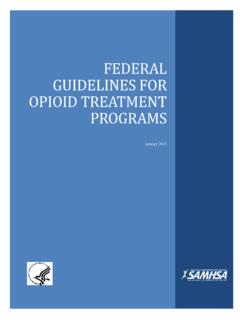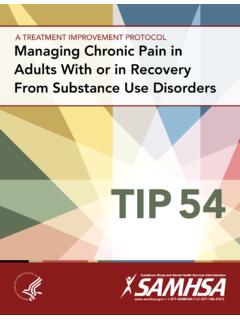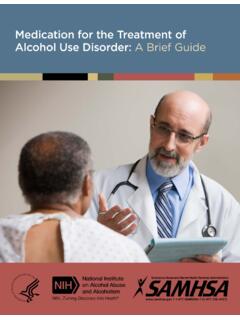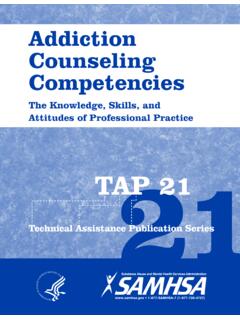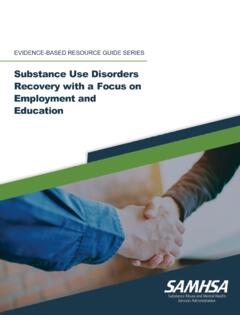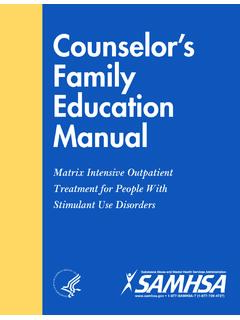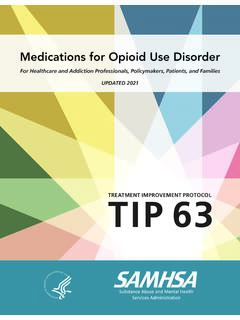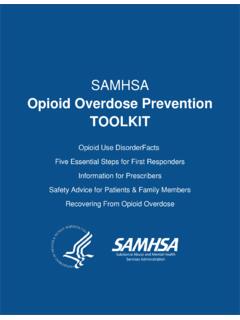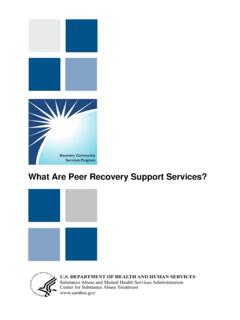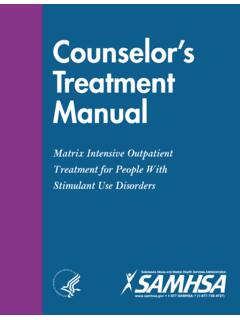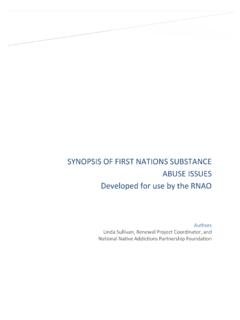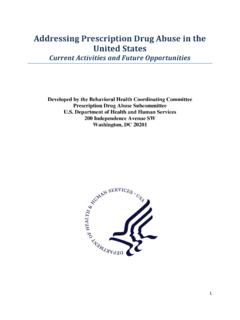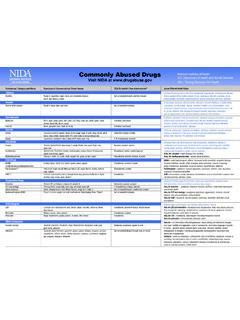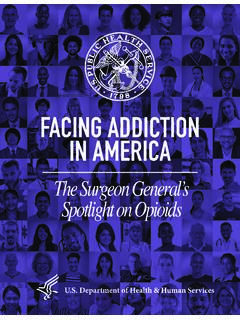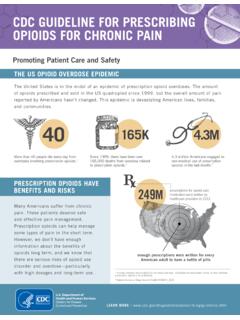Transcription of TIP 50: Addressing Suicidal Thoughts And Behaviors in ...
1 Tip_50_sui_cover_7_14_15_Addressing Suicidal Thoughts and Behaviors in substance abuse Treatment 7/14/2015 3:24 PM Page 2 Addressing Suicidal Thoughts And Behaviors in substance abuse Treatment A Treatment Improvement Protocol TIP 50 Addressing Suicidal Thoughts and Behaviors in substance abuse Treatment Treatment Improvement Protocol (TIP) Series 50 DEPARTMENT OF health AND HUMAN services substance abuse and mental health services administration Center for substance abuse Treatment 1 Choke Cherry Road Rockville, MD 20857 Editor s Note OnTIP 50, Addressing Suicidal Thoughts and Behaviors in substance abuse Treatment2017 Published in 2009, Treatment Improvement Protocol (TIP) 50 contains much information that remains useful to today s reader.
2 Noted below are topical areas where more current information and resources supplant or add to the content found in the TIP. Clinical UpdatesThe Consensus Panel was not reconvened to review and update the clinical information in TIP 50. However, a literature search covering 2009 to mid-2017 found little information that would affect the recommendations in the 2012, the Surgeon General issued a report in partnership with the National Action Alliance for Suicide Prevention 2012 National Strategy for Suicide Prevention: Goals and Objectives for The report identifies actions that behavioral health professionals can take as part of a national effort to reduce suicide. A key concept in the National Strategy is zero suicide ; this calls on healthcare workplaces to set an explicit goal of full success in preventing suicide among the patients in their care.
3 Funding for healthcare systems to implement zero suicide prevention and intervention programs is being made available by the substance abuse and mental health services administration (SAMHSA).2 Another change that has occurred since the TIP s publication is that several states and credentialing organizations have mandated or recommended training to ensure that healthcare professionals assess and address suicide Several training models for healthcare professionals are available (see the Resources section of this document).Statistical UpdateWhen TIP 50 was published in 2009, suicide was the 10th leading cause of death in the United States, with 36,909 suicides In 2015, suicide was still the 10th leading cause of death, with 44,193 suicides Between substance Use Disorders and SuicidalityResearch published after TIP 50 became available has added further evidence to the link between substance use disorders and suicidality.
4 Pertinent findings include the following: According to an analysis of SAMHSA s 2014 National Survey of Drug Use and health , which had 41,053respondents, past-year prescription opioid misuse was significantly associated with past-year frequency of2 Editor s Note on TIP 50suicidal ideation ( Thoughts of suicide); misuse at weekly or more intervals was significantly associated with past-year frequency of suicide planning and suicide In a cohort study using national administrative health records for more than million veterans, an existingdiagnosis of any substance use disorder and a specific diagnosis of alcohol, cocaine, cannabis, opioid,amphetamine or sedative use disorder were all significantly associated with a higher suicide risk.
5 The authorssuggest that the association between substance use disorders and suicide may be partially explained byco-occurring psychiatric A separate analysis of the health records for that same veteran cohort found that even after adjusting forco-occurring psychiatric disorders, tobacco use disorder remained a risk factor for ResourcesPotentially useful resources that were not included in TIP 50 are listed ResourcesAmerican Association of American Foundation for Suicide on Accreditation of Rehabilitation Facilities: Quality Practice Notice on Suicide Event Alert: Detecting and Treating Suicide Ideation in All Settings (The Joint Commission) Prevention and the Clinical Workforce: Guidelines for Training (National Action Alliance for Suicide Prevention) From SAMHSAIn Brief: substance Use and Suicide.
6 A Nexus Requiring a Public health Approach (highlights the relationship between substance use and suicide, gives an overview of the issue, and describes evidence-based programs that focus on substance use and suicide prevention) Suicide Prevention Lifeline Wallet Card (lists signs of suicide risk) National Suicide Prevention Lifeline Wallet Card is also available in -Spanish-/SVP11-0126 SPSAFE-T Pocket Card (suicide assessment five-step evaluation and triage for clinicians) Suicide Safe Mobile App (education and support resources for primary care and behavioral health service providers) Office of the Surgeon General & National Action Alliance for Suicide Prevention. (2012). 2012 national strategy for suicide prevention: Goals and objectives for action.
7 Washington, DC: Department of health and Human substance abuse and mental health services administration . (2017). Cooperative agreements to implement Zero Suicide in health systems [Webpage]. Retrieved July 7, 2017, from American Foundation for Suicide Prevention. (2016). State laws: Training for health professionals in suicide assessment, treatment, and management. Retrieved July 7, 2017, from Centers for Disease Control and Prevention. ( ). 10 leading causes of death by age group, United States 2009. Retrieved May 23, 2017, from Centers for Disease Control and Prevention. ( ). 10 leading causes of death by age group, United States 2015. Retrieved May 23, 2017, from Ashrafioun, L., Bishop, T. M., Conner, K. R., & Pigeon, W.
8 R. (2017). Frequency of prescription opioid misuse and Suicidal ideation, planning, and attempts. Journal of Psychiatric Research, 92, 1 7. 7 Bohnert, K. M., Ilgen, M. A., Louzon, S., McCarthy, J. F., & Katz, I. R. (2017). substance use disorders and the risk of suicide mortality among men and women in the US Veterans health administration . Addiction, 112(7), 1193 1201. 8 Bohnert, K. M., Ilgen, M. A., McCarthy, J. F., Ignacio, R. V., Blow, F. C., & Katz, I. R. (2014). Tobacco use disorder and the risk of suicide m or t a l it y. Addiction, 109(1), 155 162. This publication lists nonfederal resources to provide additional information to consumers. The content and views in these resources have not been formally approved by the substance abuse and mental health services administration (SAMHSA) or the Department of health and Human services (HHS).
9 Listing of these resources does not constitute an endorsement by SAMHSA or s Note on TIP 50, Addressing Suicidal Thoughts and Behaviors in substance abuse TreatmentHHS Publication No. (SMA) 15-4381 Published 2017 substance abuse and mental health services AdministrationAcknowledgmentsThis publication was produced under the Knowledge Application Program (KAP) contract number 270 04 7049 with the substance abuse and mental health services administration (SAMHSA), Department of health and Human services (HHS). Christina Currier served as the Government Project Officer. Disclaimer The views, opinions, and content expressed herein are those of the consensus panel and do not necessarily reflect the views, opinions, or policies of SAMHSA or HHS.
10 No official support of or endorsement by SAMHSA or HHS for these opinions or for particular instruments, software, or resources is intended or should be inferred. Public Domain Notice All material appearing in this report is in the public domain and may be reproduced or copied without per mission from SAMHSA. Citation of the source is appreciated. However, this publication may not be repro duced or distributed for a fee without the specific, written authorization of the Office of Communications, SAMHSA, HHS. Electronic Access and Copies of PublicationThis publication may be ordered or downloaded from SAMHSA s Publications Ordering Web page at Or, please call SAMHSA at 1 877 SAMHSA 7 (1 877 726 4727) (English and Espa ol). Recommended Citation Center for substance abuse Treatment.
